Tuesday, August 29, 2023 – LET’S THINK OF OTHER NEIGHBORHOODS TODAY


FROM THE ARCHIVES
TUESDAY, AUGUST 29, 2023
ISSUE# 1073
Tales of a hidden Brooklyn lane with a row of delightfully unusual 1870s wood houses
August 28, 2023
The city of Brooklyn came of age in the 19th century, and its houses across this booming metropolis reflect the prevailing design styles of the 1800s—from Federal-style homes with dormer windows to brownstone rows with Italianate and Romanesque Revival touches.
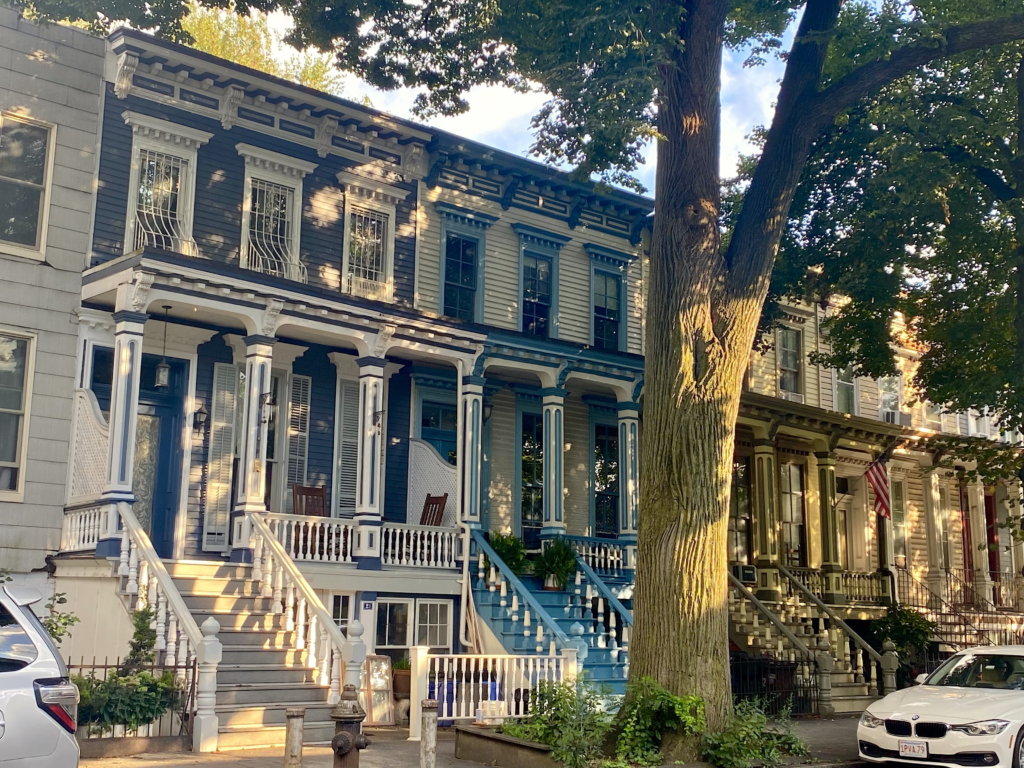
But sometimes you come across a stretch of unusually splendid residences that defy categorization and make you feel like you’ve stepped in an architectural time machine.
That’s what happened when I turned a leafy corner in Park Slope and found myself facing six brightly painted attached houses—each with tall parlor floor windows, fancifully painted cornices, and wide columned front porches that seem more Charleston than the City of Churches.
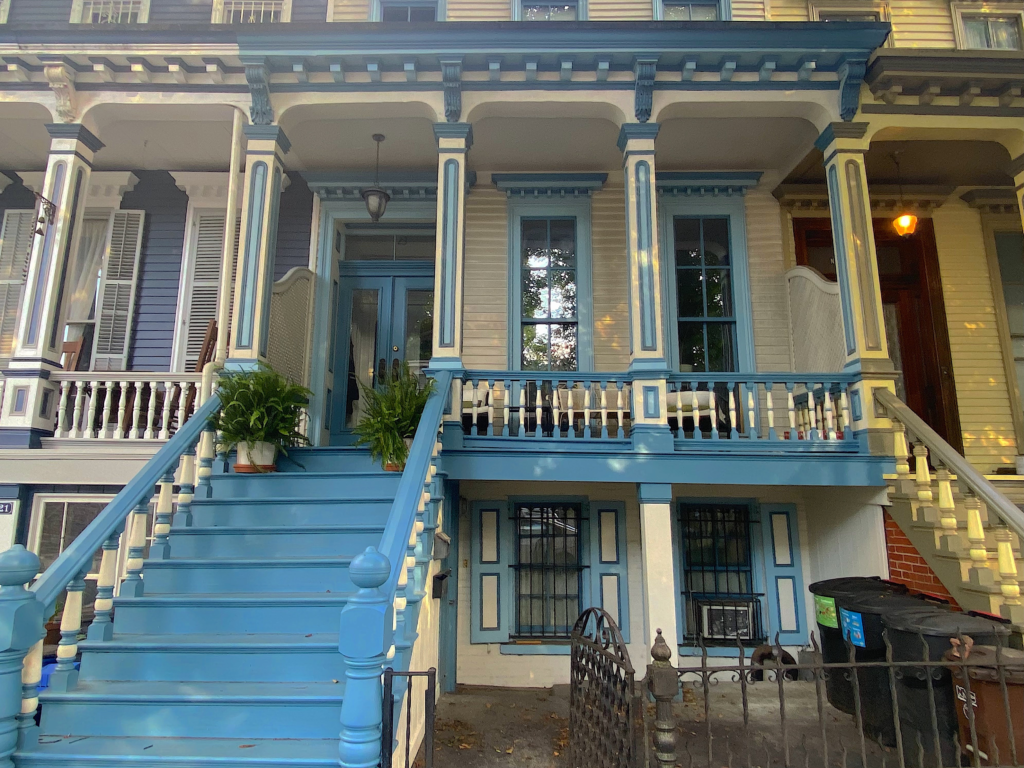
These country-like houses are on Webster Place, a one-block lane hidden inside 16th Street and Prospect Place and Sixth and Seventh Avenues. Shrouded by billowy tree tops and beautifully symmetric, they’re remnants of a post-Civil War building frenzy that remade many of the rural-ish neighborhoods collectively known as South Brooklyn into sought-after residential enclaves.
The homes are treasures in modern-day Park Slope—a unique blend of Queen Anne style because of the porches and wood trim, as well as Classical thanks to the wood columns. But the story of Webster Place and these six houses also offers a glimpse into what life was like in the rapidly urbanizing Brooklyn of the late 19th and early 20th century.

Numbers 21-31 Webster Place were likely built in the 1870s. Notices in Brooklyn newspapers announcing the sale of land lots on the tiny street began appearing in the late 1860s.
The name of the street is a mystery—why Webster? It could have been the name of a developer; perhaps it was in honor of well-respected New England statesman Daniel Webster, whose 1850 death was commemorated in New York by the closing of businesses on the day of his funeral.

In any case, at about the same time the houses (above, in 1940) were being planned and constructed, Webster Place was joining the cityscape. The secluded lane was paved and graded in the late 1860s. In 1871, the Brooklyn Common Council passed an ordinance that put gas street lamps on Webster Place. A year later, the street was officially opened.
Bits of information on the continuing development of the street emerged from newspaper archives. In the 1880s and 1890s, a grocery store popped up on the corner at 16th Street. Houses traded hands; the going price was around $3000.
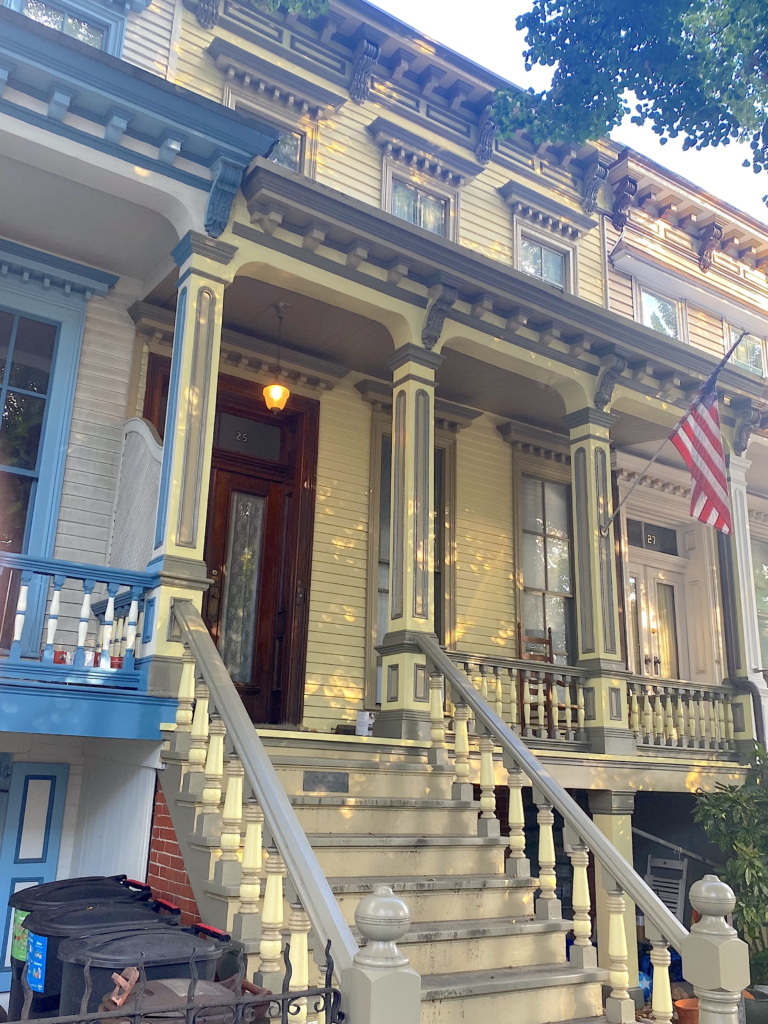
But a 1943 Brooklyn Daily Eagle column on the remembrances of the borough’s “old timers” turned up some details that fill in the blanks of daily life on this slender lane at the turn of the century.
“Yes, Webster Place was a fine and clean little street with shade trees on both sides,” recalls a man named George Chevalier, who also mentioned the grocery store and a feed store on the block.
Chevalier remembered Webster Street neighbors who “had a team of billy goats and a patrol wagon and gave us a ride in it. Boy, how us kids did enjoy it!” The owner of the grocery store “would leave his horse sleigh on the sidewalk in front of the store and we would play in it, and I used to go for a ride with him when he would be delivering orders in the neighborhood.”
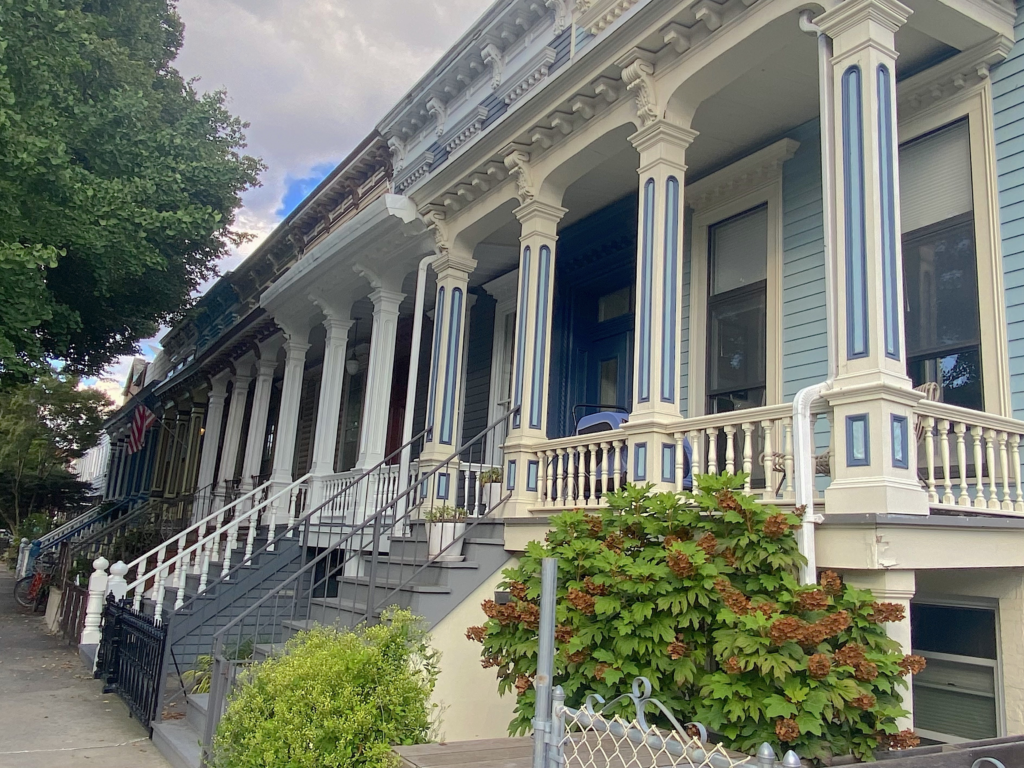
Another old-timer said his family has lived at 22 Webster Place (across the street from the splendid row of houses) since 1878. “I still remember the white houses with their green shutters and the tall trees lining both sides of the street, forming an arch over the roadway.”
This Webster Street resident recalled the families who lived on the block when he did; he listed a mix of English, Irish, and German last names. He also mentioned that the street was paved with cobblestones, “for I was one of those who swept them off every morning.”
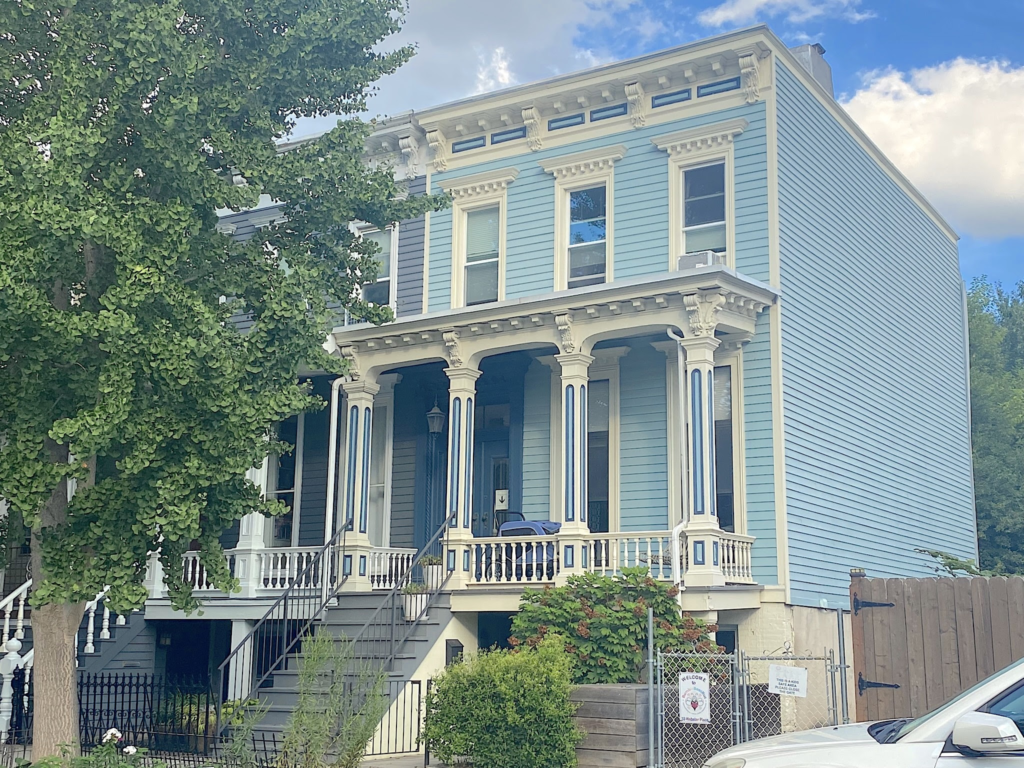
Around the corner was a dairy that offered fresh milk from grazing cows. He further noted the nightly occurrence of “the lamplighter coming along with his ladder and taper to light the gas lamps.”
The cows are long gone, the lamplighter departed for good, and I doubt very much that any of the residents of 21-31 Webster Place get around by horse-drawn sleigh.
But these spectacular houses—with their welcoming stoops and porches, now slightly modified and not always matching their neighbors—reflect the sensibilities of 19th century Brooklyn as the city transitioned from rural county to urban metropolis, and then a borough of the city of New York.
Sometimes they even come up on the real estate listings. Number 23 was for rent earlier this year; take a look at the gorgeous interior shots that allow a peek into the backyard.

NOW IN EFFECT
THE SHUTTLE OPERATES 5 A.M. TO MIDNIGHT DAILY
The “F”SHUTTLE TRAIN WILL ONLY RUN BETWEEN 21 ST/QUEENSBRIDGE, ROOSEVELT ISLAND TO LEXINGTON AVE./63 ST. STATIONS. THERE IS ONE “F” SHUTTLE TRAIN ON ONE TRACK GOING BACK AND FORTH FROM 5 A.M. TO MIDNIGHT DURING THE WEEK.
TIMES TO REMEMBER:
F SHUTTLE DEPARTS ROOSEVELT ISLAND STATION EVERY HOUR ON THE:
:02 PAST THE HOUR
:22 PAST THE HOUR
:42 PAST THE HOUR
RETURNING
F SHUTTLE DEPARTS 63 ST/ LEX STATION EVERY HOUR ON THE:
.10 PAST THE HOUR
.30 PAST THE HOUR
.50 PAST THE HOUR
THERE ARE NO TRAINS GOING EAST TO QUEENS AFTER QUEENSBRIDGE. THERE ARE BUS CONNECTIONS FROM THAT STATION OPERATED BY THE MTA.

Q TRAIN CONNECTIONS AVAILABLE FROM 63/LEX STATION SOUTHBOUND
Q TRAIN TO 57 STREET & 7 AVENUE
Q TRAIN TO 42 STREET TIMES SQUARE (CONNECT HERE TO F TRAIN VIA PASSAGE)
Q TRAIN TO 34 STREET (CONNECT HERE TO F TRAIN)
Q TRAIN TO 14 STREET UNION SQUARE
Q TRAIN TO CANAL STREET (OVER MANHATTAN BRIDGE TO BROOKLYN)
Q TRAIN CONNECTIONS AVAILABLE FROM 63/LEX STATION NORTHBOUND (72 ST., 86 ST., 96 ST AT SECOND AVENUE)
- Overnights between midnight and 5 a.m., F shuttle train service is suspended and free Q94 shuttle buses will connect the Roosevelt Island, 21 St-Queensbridge, and Queens Plaza stations. These are MTA buses.
TUESDAY PHOTO OF THE DAY
SEND YOUR RESPONSE TO:
ROOSEVELTISLANDHISTORY@GMAIL.COM

Text by Judith Berdy
Thanks to Bobbie Slonevsky for her dedication to Blackwell’s Almanac and the RIHS
EPHEMERAL NEW YORK
JUDITH BERDY
RIHS
[Fourth photo: NYC Department of Records & Information Services]
Tags: Brooklyn Wood Row Houses Webster Place, Old Brooklyn Row Houses 19th Century, Webster Place Brooklyn, Webster Place Park Slope, Webster Place Secluded Streets in Brooklyn, Wood Row Houses of Brooklyn
Posted in Brooklyn
Thanks to Deborah Dorff for maintaining our website
Edited by Melanie Colter and Deborah Dorff
MAYA LEVANON-PHOTOS TIK TOK & INSTAGRAM
All image are copyrighted (c) Roosevelt Island Historical Society unless otherwise indicated
www.tiktok.com/@rooseveltislandhsociety
Instagram roosevelt_island_history
THIS PUBLICATION FUNDED BY DISCRETIONARY FUNDS FROM CITY COUNCIL MEMBER JULIE MENIN & ROOSEVELT ISLAND OPERATING CORPORATION PUBLIC PURPOSE FUNDS.


Copyright © 2022 Roosevelt Island Historical Society, All rights reserved.Our mailing address is:
rooseveltislandhistory@gmail.com

Leave a comment